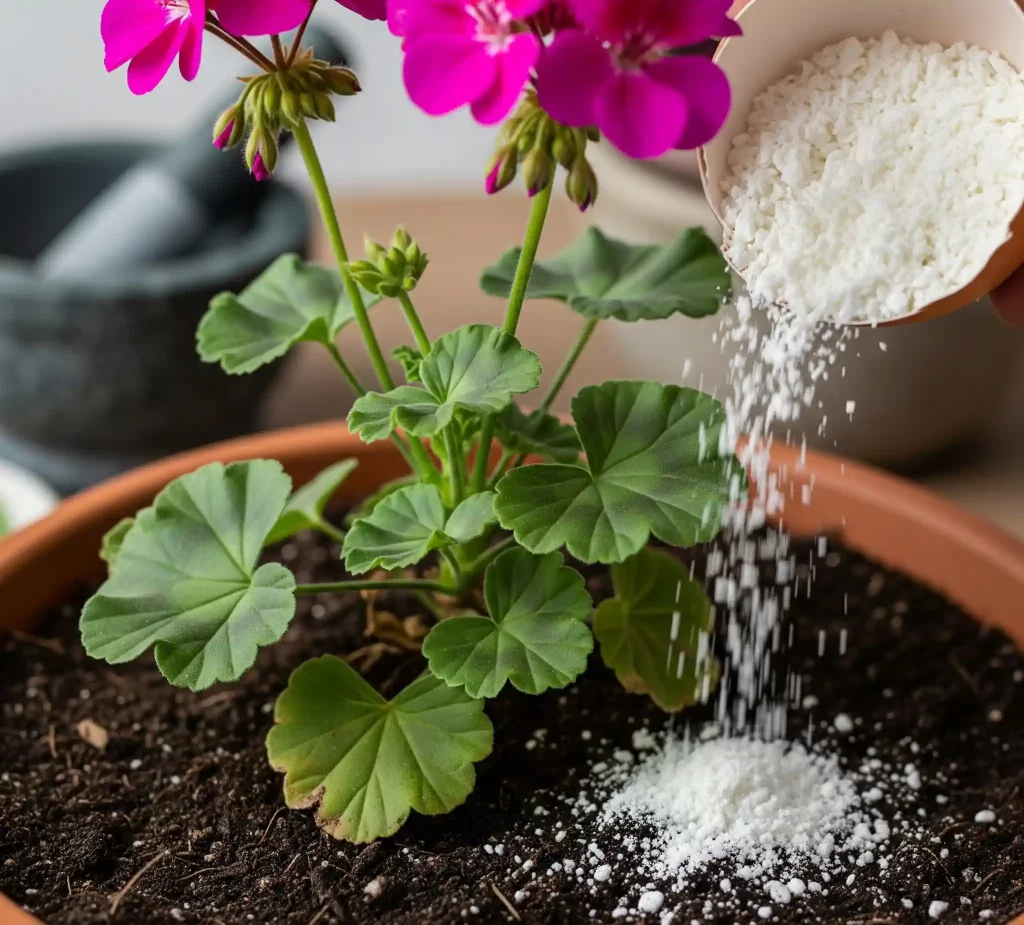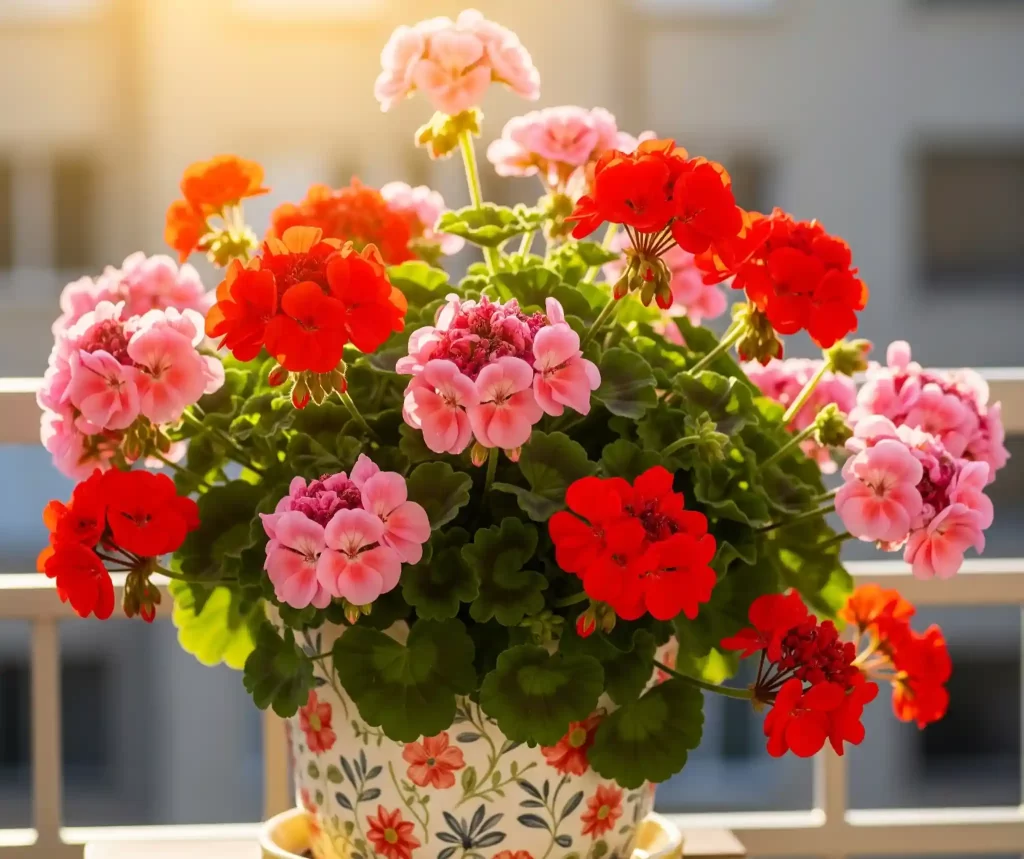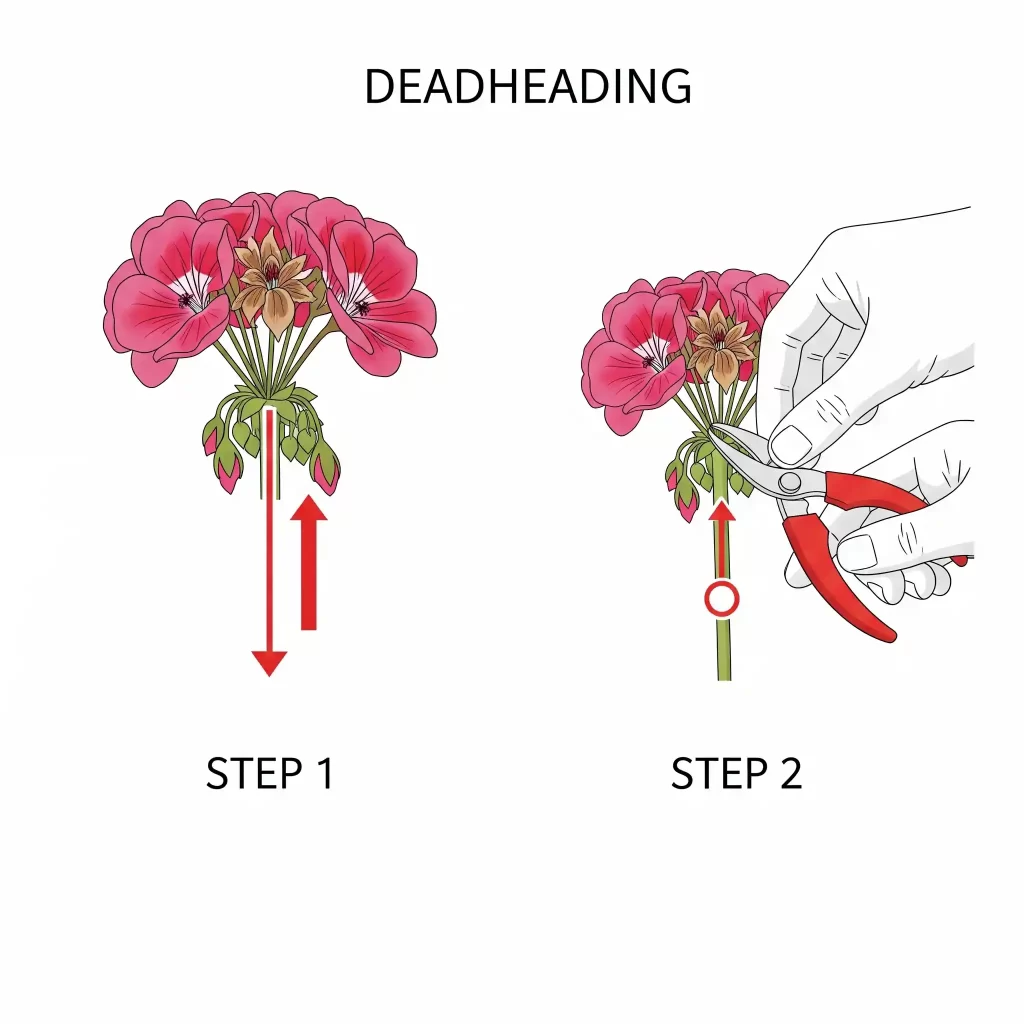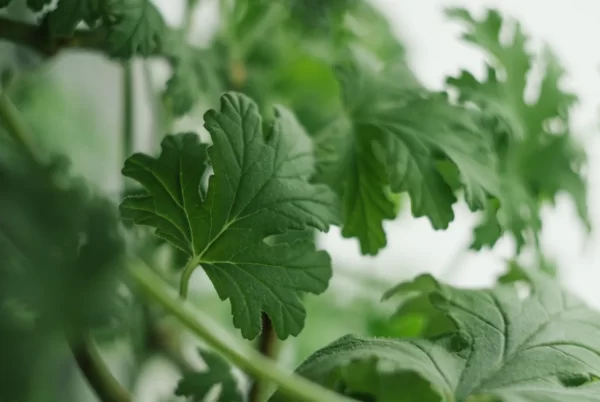The Gardener’s Secret Weapon for More Flowers (and It’s in Your Kitchen!)
Every balcony and container gardener understands this feeling: you buy lovely geraniums (Pelargoniums) with dreams of colorful blooms streaming down, but you end up with a pot of lush green foliage and very few blossoms. You can feel like you’re doing something wrong. But what if the secret to a beautiful flower eruption wasn’t in a pricey, colorful bottle from the garden center, but was already in your kitchen?
The reality is that you can get your plants to bloom fully by utilizing simple, effective, and almost free fertilizers created from things you already have in your kitchen. This method not only saves you money, but it also cuts down on waste by putting your “trash” to work making things beautiful.
Recipe 1: Banana Peel Tea, the Potassium Powerhouse
This is the best DIY fertilizer for getting flowers to grow. Banana peels are quite high in potassium (K), which is the main ingredient that helps buds and blooms grow and keeps plants healthy and strong.
To create it, just put one or two fresh banana peels in a big jar of water and let them soak for 24 to 48 hours. As the potassium leaks out, the water will have a light, cloudy appearance. Take off the peels (you may throw them in your compost) and use this “tea” full of nutrients to water your geraniums.
Recipe 2: The Calcium Builder (Crushed Eggshells)
To hold up a lot of heavy flower heads, the stems need to be strong and durable. Eggshells are a great supply of calcium, which is what makes plant cell walls robust.
How to do it: The next time you make eggs, wash the shells and let them dry all the way. Use a coffee grinder, blender, or mortar and pestle to ground them up into a fine powder once they are dry. Once or twice a season, add a tablespoon of powdered powder to the soil around each plant. It will break down slowly, giving you a continuous dose of calcium.

From What I’ve Seen
Years ago, I stopped using pricey, brilliantly colored “bloom booster” fertilizers that you can buy in stores. I get stronger plants and more blossoms than any product I’ve ever bought by watering them once a week with diluted banana peel tea during the growing season. This is the easiest and best tip I know, and my plants have never been happier.
The Science of a Flower Factory: What Your Geranium Really Wants to Eat
To understand why DIY remedies like banana peel tea work so effectively, you need to know the basics of what your geranium really wants to eat. The N-P-K ratio is the three digits on every fertilizer package. The key to getting more blooms is to know this ratio.
- N—Nitrogen (The “Salad Course”): Nitrogen’s main duty is to help plants grow green and leafy. It helps the plant manufacture chlorophyll, which is the color that makes leaves green. When a plant gets too much nitrogen, it gets a hormonal signal to put all of its energy into making new leaves, which can mean that it doesn’t make flower buds.
- P—Phosphorus (the “Main Course”): Phosphorus is important for moving energy around in the plant. It helps plants grow strong roots and is necessary for the complicated process of making big, colorful flowers.
- K—Potassium (the “Vitamin Supplement”): Potassium is good for your health in every way. It helps the plant use water more efficiently, makes it stronger against disease, and is very important for producing a huge flower display.
The problem is that a lot of all-purpose potting soils already have a lot of nitrogen in them, which makes plants look healthy and green at the nursery. You keep feeding the plant a diet that makes leaves grow instead of flowers after you bring it home. You need to lower the nitrogen and raise the potassium to start a bloom explosion.
Think of it this way: Nitrogen is the “vegetable” course for your plant, and Phosphorus and Potassium are the “dessert.” It will grow huge and green if you simply give it veggies, but you will never receive flowers. Your banana tea is the best dessert ever.
Sun, Water, and Potting: The Three Things That Make Up a Balcony Flower Show
If you don’t provide the plant’s basic needs, even the strongest fertilizer in the world won’t function. When growing geraniums in pots, it’s really important to get the basics correct. The regulations are a little different than when growing them in the ground.

More sunlight is better
Pelargoniums come from South Africa and love the sun. They need at least 6 to 8 hours of direct sunlight every day to have the energy to keep making blossoms. A balcony that faces south or west is best. But keep in mind that a balcony can make the heat from walls and windows more strong and reflected. In places where it gets really hot, a small bit of shade from 3 to 5 p.m. can keep the plant from getting too stressed and stop the leaves from growing too heated.
Watering: Learn the “Drench and Dry” Method
This is the most important thing for any gardener who uses containers. Too much water is the biggest threat to potted plants. Don’t water your plants on a strict timetable; instead, get to know their rhythm.
The “Drench and Dry” approach is easy: Give the plant a lot of water until it comes out of the drainage holes at the bottom of the pot. This makes sure that the whole root ball is wet and helps get rid of any salt accumulation in the soil. After that, don’t water again until the top 1 to 2 inches of soil feel fully dry. This cycle helps the roots develop strong and deep, and it gives them the oxygen they need to breathe, which stops root rot from killing them.
Potting soil: Drainage is key
Geraniums don’t like “wet feet.” The soil in a pot should hold adequate water for the plant, but it should also let the extra water drain away fast. Don’t use heavy garden soil; instead, use a high-quality potting mix made just for pots. You can make it even better by mixing two parts good potting mix with one part perlite or pumice. This makes air pockets in the soil, which helps the roots stay happy and the water drain well.
The “lift test”
The best way I’ve found to water pots on my balcony. I can tell how heavy a pot is shortly after I water it deeply and when it’s completely dry. A short lift lets me know right away if it’s time to water, which is far more accurate than just glancing at the soil surface, which can be misleading.
Should I Snip or Not? How to Deadhead Flowers So They Keep Blooming
Pruning is like talking to your plant directly. You can send a clear message to stop wasting energy and start creating more blossoms with just a few easy cuts.
Method 1: Pinching to make a plant bushier
This is a technique that works well in the early summer and all summer long. When your geranium is still young and has only a few main stems, use your fingers to “pinch” off the top half-inch of the main growing tips. This cuts off the main bud (the apical bud) and makes the plant direct its energy to the dormant side buds further down the stem. The plant is now considerably thicker and bushier, with twice as many stems, which means it can grow twice as many blooms.
Technique 2: Deadheading to Get More Flowers
You have to be very strict about getting rid of the dead flowers on your plant once it starts to bloom. But the way you do it is important. Don’t merely take off the fading petals. The main job of a flower is to make seeds, and as long as the base of the flower head is still attached, the plant will keep sending energy to it.

To deadhead correctly, follow the stem from the flower head that has already died all the way down to where it meets the main stem of the plant. At this point, you can either snap it off or cut it off. This provides a clear and fast message to the plant: “Seed production has failed. Try again!” Then, with astonishing speed, the plant will use that energy to make new flower buds.
Tip from an expert
Add deadheading to your morning coffee routine. It only takes a minute to check on your flowers every day and cut off any that are fading. This makes a huge impact. It’s the most gratifying gardening chore that gives you the greatest immediate benefit, and it helps you find any insect problems before they become worse.
The Great Epsom Salt Debate: Is it a Miracle Cure or a Garden Myth?
There is a lot of advice online about how to use Epsom salts on geraniums. It’s crucial to know what it is and what it does before you do it.
Magnesium sulfate is what Epsom salt is made of. Chlorophyll, the chemical that makes leaves green, needs magnesium to work. Interveinal chlorosis is a clear sign of a real magnesium deficiency. This is when the leaves become yellow but the veins stay green. This is quite rare in pelargoniums cultivated in a good potting mix.
The conclusion is that Epsom salt can help with a certain nutrient deficit that makes leaves become yellow, but it won’t let flowers bloom. If your leaves are green and healthy but you don’t have any blossoms, magnesium isn’t the problem. Overusing Epsom salts can actually stop the plant from taking in other important elements, including calcium, because they change the balance of nutrients in the soil. If you detect the traditional yellow-leaf-green-vein symptom, you should only think about using Epsom salts. Otherwise, stick to your potassium-rich banana peel tea for blooms.
How to Keep Geraniums Over the Winter in an Apartment
One of the best things about pelargoniums is that they are delicate perennials, which means you can easily keep them alive throughout the winter and enjoy them again next year. It’s easy for someone who lives in an apartment and doesn’t have a cool basement.
- The Haircut and Cleanup: Before the first severe frost in the fall, bring your plant inside and give it a big haircut. Cut it back by half to two-thirds, taking off any dead or yellowing leaves and blossoms that are still there.
- The Pest Check: This is a very important phase. Look closely at the stems, leaves (top and bottom), and the soil surface for any pests that may have hitched a ride, such as aphids or whiteflies. Before putting the plant next to any other houseplants, spray it with insecticidal soap if you spot any.
- The Sunny Spot: Put your geranium in the window that gets the most light and sun. A window that faces south is best. The plant won’t get enough light to flower, and it will probably get a little stretched out and “leggy.” This is completely typical and fine.
- The Water Diet: This is the most important thing to do to stay healthy over the winter. The plant will need a lot less water when it gets less light and grows more slowly. You should only water it once every two to three weeks. Make sure the soil is completely dry before watering again. You don’t want to make it grow more; you just want to keep it alive in a condition of semi-dormancy.
- The Spring Awakening: In the spring, when there is no more risk of frost, it’s time to wake up your plant. Start the “hardening off” process by slowly getting it used to being outside again over the course of a week. Start with an hour in the shade, then two hours the next day. Gradually increase the duration and add some light morning sun before moving it to its sunny summer habitat.
It’s not as hard as you think to make a colorful balcony
You don’t need to spend a lot of money or have a degree in horticulture to get a beautiful, overflowing display of geraniums on your balcony. All you have to do is know what this hardy, sun-loving plant really needs. You may make a floral paradise by learning the basics of how to care for containers and giving your plants the necessary nutrients, which you probably already have in your kitchen.
Your keys to success are:
- Give your geraniums potassium, not nitrogen, to get more flowers. A simple tea made from banana peels is the best free “bloom booster.”
- Learn how to “drench and dry” your plants to keep their roots healthy.
- Pinch the plant early to make it bushier, and deadhead it the right way by cutting off the whole flower stalk to get more flowers.
- To keep your plants alive till next year, all you need is a sunny window and a rigorous water diet.
Questions that are often asked (FAQ)
What makes a Geranium different from a Pelargonium?
The typical “geranium” that you buy for your pots and window boxes is actually a Pelargonium, a delicate perennial that grows in South Africa. People commonly call true geraniums “cranesbills.” They are hardy perennials that can live in the ground through the winter in most areas. Their blossoms are usually smaller and more fragile.
Why are the leaves on my geranium going yellow?
This is nearly always a hint that you need to water your potted geraniums. Overwatering is the main reason, which makes the leaves turn yellow all throughout as the roots start to die. If you don’t water your plants enough, they can also turn yellow, but the edges of the leaves will usually be crispy brown. A consistent yellowing of the bottom leaves can also mean that the plant doesn’t have enough nitrogen, but this is less common.
Can I put coffee grounds on my geraniums?
Most of the time, it’s not a good idea for geraniums in pots. Coffee grounds do provide some nitrogen, but pelargoniums don’t need a lot of it. More crucially, the fine grounds can pack down the soil in a container, holding in too much water and making it hard for air to get to the roots, which could cause root rot.
Why do my ivy geraniums have long stems and few flowers?
This is nearly often an indicator that there isn’t enough direct sunshine. Ivy geraniums (Pelargonium peltatum) need more light than regular zonal geraniums. They need at least 6 to 8 hours of direct, bright sunlight every day to stay small and bloom a lot.
What kinds of Pelargoniums do best on a hot, sunny balcony?
The typical upright zonal pelargoniums (Pelargonium x hortorum) with a “zone” of darker color on the leaf are usually the strongest and can handle the heat the best. Ivy geraniums look great in hanging baskets, but in really hot places, they can need some cover from the hottest midday sun. People grow scented-leaf plants like lemon, rose, and mint more for their aromatic leaves than for their small, fragile flowers.



